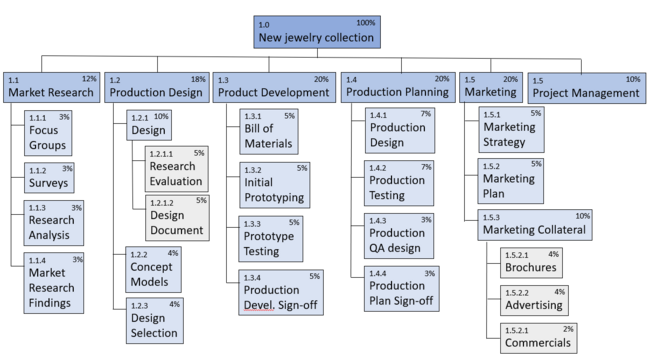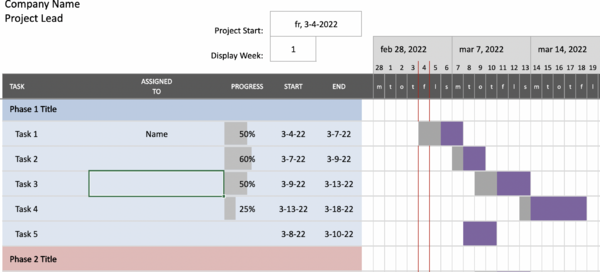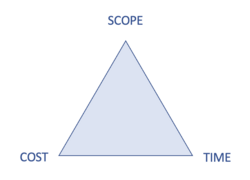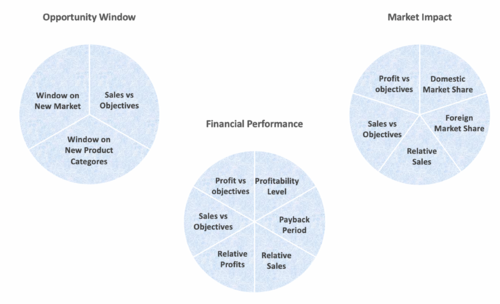Project success vs Project management success
Two perspectives need to be considered when evaluating a project’s performance: project management success and project success.
Project management success responds to the question “Was the project done right”? This relates to efficiency in the project which translates into delivering the project within the constraints: scope, quality, and time. Some activities that enable project management success are planning and scheduling, cost, and risk management [1].
On the other hand, project success answers the question “Was the right project done”? This relates to the effectiveness of the project, which translates into the long-term benefits and value of the project. Some of the factors that enable project success are the cooperation of both project management and line management and aligning projects with the organisation's strategy and goals [2].
Even though one kind of success does not guarantee the overall project success, several studies have shown a correlation between these two kinds of success. The chances of the overall project's success rise when the right planning, budgeting, and scope are defined in advance [3]. Many frameworks have been developed to measure the different types of success. Some of them fully focus on overall success, such as "The relative importance of project success dimensions” developed by Stan Lipovetsky. This framework suggests measuring project success by evaluating four different dimensions: meeting design and planning goals; customer benefits; benefit to the implementing organisation; and benefit to the infrastructure [4]. Alternatively, other frameworks only focus on one kind of success, such as the Iron Triangle of Projects, which involves the three main constraints in Project Management: cost, quality and cost [5].
One of the main limitations when evaluating overall project success is that it can be very challenging defining and measuring success criteria. As viewpoints and priorities differ, individuals will perceive success differently[6]. Furthermore, effectiveness measures are less tangible and, as they are focused on long-term benefits, they are more difficult to estimate [7].
Contents |
Big idea
The way in which a project's success is measured has evolved over time. Traditionally, projects were measured using a classic approach. Nowadays, the trend is to move towards using a state of the art approach [8].
- The classic view focuses on the requirements of the project, short-term output and time, cost and scope.
- The state of the art view evaluates the overall business case, the vision, long-term benefits and the success criteria. This view makes it harder to assess a project's success as it is more vague and harder to quantify.
A common description of a project manager’s goal is to manage projects in such a way that brings completion on time, within budget and that ensures the intended quality [9]. Hence, quality and scope should be defined from the very beginning of the project. Even though the right planning of the project does not guarantee success, the lack of planning will most likely cause it to fail. Therefore, one would assume that defining the right planning, budgeting and scope clear in advance would at least, increase the chances of a project’s success. However, there have been many projects that followed the initial plan, leading to completion within time and budget while meeting previously defined success criteria but ended up failing. These projects failed to provide long-term value for the company or produce any benefits for stakeholders [3]. Therefore, to assess a project’s success, two perspectives have been defined [10]:
- Project management success is based on delivering the requirements on time within budget. It is associated with efficiency, which is doing things right. Successful project management means planning in the right way and following the plan.
- Project success is based on the long-term benefits and value of the project. It is associated with effectiveness, which is the capability of delivering the desired result.
Project Management Success
Project management success answers to the question: “Was the project done right?”. A project manager must manage time, cost, and quality. Once the objectives and business case of a project have been clearly defined, the project manager and their team should use the available resources to meet the objectives within the constraints. On the other hand, projects are always characterised by a certain level of uncertainty, which will most likely change the course of the project. To minimise risks and their consequences, it is also essential for the project manager to make proper risk management and monitoring plan to make sure that the project is still delivered within the given constraints [1].
The main activities of a project manager to enable project management success are the ones that follow [11]:
- Planning: Defining the project deliverables and requirements and define how the project objectives should be met.
- Benefit Management: Making sure that the customer realises the benefits described in the business plan.
- Scope Management: Determining and documenting the outputs, outcomes and benefits of a project.
- Resource Management: Plan, allocate and schedule the available resources in the most efficient way
- Schedule Management: Forecasting the start and end date of all activities in a project
- Cost Management: Estimating, budgeting and controlling the costs involved in a project
- Risk Management: Listing and assessing all possible risks for a project, as well as making a mitigation plan to reduce or cancel the effects.
- Issues Management: Resolving issues to make sure there is not a negative impact in the project
- Change Control: Controlling changes and accepting or rejecting them
- Quality Management: Establishing standards for the project as well as the steps to meet them
- Stakeholder Engagement: Understanding, building and maintaining relationships with the stakeholders of the project
- Communication Management: Enabling effective communication with stakeholders to contribute to the project’s goals completion
- Managing organisational and societal change: Ensuring the delivery of desired outcomes under changes in both the organisation and society
- Reporting: Presenting the current status of the project to forecast and make educated decisions
- Information and documentation Management: Making sure the necessary information is available for those making decisions
- Procurement: Obtaining the necessary products and services for the project’s completion
- Lessons learned: Documenting and sharing the lessons learned of a project to use in future projects
Project Success
Project success answers to the question: “Was the project right project done?”. Project success occurs when the project delivers the benefits that were anticipated by the stakeholders who initiated the project. Usually, this type of success has to do more with "value for money" and it's probably the most valuable to the sponsor. Project success is harder to evaluate than project management success since the benefits of a project are often realised after completion, not during the lifecycle of the project [2]. However, several studies have been made concluding that some of the factors that enable project success are the ones that follow [12]:
- A process for delivering and managing benefits that involves the cooperation of both project management and line management.
- Manage projects according to an organisation's strategy and goals by utilising portfolio and programme management practices.
- Project, program, and portfolio metrics that provide direct feedback on current project performance and future success to make sure that project, portfolio, and corporate decisions are consistent.
- Using implicit and explicit knowledge to achieve continuous improvement in the management of projects. This should encourage project managers to learn and integrate such learning into continuous improvement in practices and processes.
Application
Many different frameworks have been developed throughout the years to help achieve and measure project and project management success. Some of these methods will be presented in this article divided based on whether they are related to project management success, project success or overall success.
Project Management success
Work Breakdown Structure
Developing a Work Breakdown Structure (WBS) is the foundation for initiating, planning, executing, monitoring and controlling a project [13]. A WBS is especially useful for complex projects as it consists in breaking it down into more manageable individual components in a hierarchical structure. To create the WBS, the project manager and technical team need to define the main project deliverables. Afterwards, the defined deliverables are decomposed into smaller activities. These activities can be decomposed into smaller tasks. The number of times that the activities are broken down depends on each project and project manager. One can set rules for how small the activities should be, for example, all activities need to last less than ten hours. Once the WBS has been defined it is much easier to make cost and time estimates for each individual activity, as well as risk identification [14].
Gantt Chart
A Gantt chart is a project scheduling tool where all the project activities are represented against time. Each activity has a start and end date, as well as duration. All activities are represented in a timeline as horizontal bars. The length of the bars depends on the duration of the activities and the position depends on the start time. In order to be able to build a Gantt chart, all the interdependencies between activities need to be defined to be able to place each activity in the right position in the chart. Gantt charts give an overview on timelines and deadlines of all activities, relationships and dependencies between activities as well as the different project phases. If a Gantt chart is going to be used to monitor the time constraint of a project, it should be developed at the beginning of the project, once all activities have been determined. Once the project has started, the actual progress needs to be compared against the initial plan in the Gantt chart, which can be adjusted throughout the project if needed [15].
Iron Triangle
The Iron Triangle, also sometimes referred to as the Project Management Triangle or the Triple Constraint, is a tool that represents the relationship between the three most basic success criteria and constraints in project management: cost, scope and time. This tool is based on the fact that the three criteria/constraints are interrelated. Fixing or changing one of the constraints the triangle will have an impact on the other two. This means that if, for instance, the budget of the project is reduced, either the time will need to be longer or the scope will need to be narrowed down [5]. In order for a project to be successful from the project management perspective, the project manager needs to find the right balance between the three vertices of the triangle [16].
Project success
The three dimensions of performance by Cooper and Kleinschmidt
Previous studies to this framework had suggested that project success was a simple, one-dimensional concept. However, Cooper and Kleinschmidt believed otherwise and examined ten independent measures that defined project success. It was concluded that these measures could be simplified and represented as the combination of three different dimensions related to each other: financial performance, opportunity window and market impact. These are called the three dimensions of performance [17].
The ten independent measures to define project success and their definition are shown in Table 1.
| Measure | Definition |
|---|---|
| Profitability Level | The extent to which a product's profitability exceeded expectations compared to the minimum acceptable level of profitability. (Traditional measure of success or failure) |
| Payback Period | Amount of time required for the project's investment to reach the break-even point (It is a negative measure - the higher the value the worse the performance) |
| Relative Sales | Sales of the product in terms of other recent new products introduced by the firm (last 5 years). |
| Relative Profits | Profits of the product in terms of other recent new products introduced by the firm (last 5 years). |
| Sales vs Objectives | Amount of sales (dollars) exceeding or falling short of sales targets. |
| Profit vs objectives | Amount of profit exceeding or falling short of profit targets. |
| Domestic Market Share | Market share in the third year after launch in the domestic market. |
| Foreign Market Share | Market share in the third year after launch in the foreign market. |
| Window on New Product Categories | Whether the product opened up new product categories for the company. |
| Window on New Market | Whether the product opened up a new market for the company. |
Figure 4 shows the three dimensions of performance and the measures they encompass
Overall success
Critical Success Factors
It is crucial to identify critical success factors which can be managed to enhance project success rates. Ten Critical Success Factors (CFS) were found to be key predictors of a successful project. These CSFs are [18]:
- The aim of the project mission
- Client approval
- Top management support
- Communication
- Involvement of the client
- Technology aptness
- Appropriate supervision and feedback
- Enough contingency plans
- Project schedules and plan
- Project personnel
Further development of this framework led to the statement that these ten critical success factors can be managed or controlled to some extent by the project management team. Therefore, four elements outside the project management process were added to the theory. These are [19] :
- Project team leader attributes
- Environmental occurrences
- Contingency
- Power and politics
The Relative Importance of Success Dimensions
This framework suggests measuring project success by evaluating four different dimensions:
- Meeting the design goals
- Benefit to the customer
- Benefit to the developing organization
- Benefit to the defense and national infrastructure
This framework also sorts these criteria by importance when measuring project success being the benefit to the customer the most relevant one followed by meeting the design goals. Other success dimensions play a relatively small role. Consequently, managerial activities should be focused so that customer benefits and design goals are achieved [4].
Limitations
Some of the limitations that authors have found when trying to define and measure project success are the ones that follow:
Narrow success criteria
A limited set of criteria is used to evaluate the overall success of a project, focusing only on those factors that contribute to project management success. The result may indicate a lack of alignment between the project and the organisation's goals. In those cases, the organisation faces several problems during the execution phase, such as a lack of top management support, which is considered crucial for project success [20] .
Ambiguity
Many success criteria do not have a strict definition and can be interpreted differently. Ambiguity is mainly related to project success criteria as they have a broader definition and are less tangible. The success criteria for project management are normally not affected by this issue because cost, quality and time are characterised by numerical values. An example of ambiguous criteria is customer satisfaction, as it is very difficult to quantify. Subject interpretation of success criteria can lead to changes in priorities, inadequate allocation of resources and misunderstandings between the project team, stakeholders and managers [7].
Diversity
The formulation and selection of success criteria is complicated by the diversity of stakeholder interests, authority, and influence. Geographical locations, country cultures, work methods, misperceptions of aims, and diversity of talents or disciplines used in a project are all examples of stakeholder diversity. The difficulty that projects encounter is balancing the various, and sometimes contradictory, expectations of all stakeholders [6].
Lack of completion
Lack of full awareness of the variety of project stakeholders at start-up, or lack of understanding of the full range of uses of the product or system that challenges the definition of project success criteria. This is a result of the uncertainty that all projects face during the initial stages. This may lead to an inadequate definition of the set of success criteria. This could result in inefficient resource allocation, disagreements within the project organisation [16].
Unrealistic goals
The over enthusiastic or pessimistic anticipation for the aim of, for example, time, budget, or expected benefits is one factor that contributes to the imprecise determination of success criteria. This may cause stakeholders to regard a project as a partial failure even though it was effective in generating positive results [21].
Lack of prioritisation
Many projects fail when defining relative importance of the success criteria. The absence of prioritising can lead to harder decision-making throughout the project as well as overall project success evaluation [22].
Subjectivity
The majority of the frameworks defined in this article sum up some of the most relevant metrics to measure project success. Despite some success criteria standing out among all relevant criteria, most authors are unable to agree on which are the most significant ones. Therefore, there is no universal framework or definition of project success, which leads to project success being, to some extent, subjective [23].
Annotated bibliography
The ‘‘real’’ success factors on projects. The quest for success in project management has been on for decades, and researchers have found numerous factors that have been reflected in project management literature. This article identifies twelve factors that are key to project success, project management success and overall project success using empirical research. In order to do this, the author studies overall project success by answering the following questions: “What factors lead to project management success?”, “What factors lead to a successful project?” and “What factors lead to consistently successful projects?”
ISO 21502. Project management guidelines are presented in this document. These guidelines apply to any organization, as well as to any type of project. Within the context of project management, the document describes high-level practices that are considered to generate successful results. All project management concepts, prerequisites and project management practices are defined in this document. The document covers the whole life-cycle of any project in all kinds of industries.
An empirical analysis of the relationship between project planning and project success. This article studies the relationship between project management and overall project success. Three project management practices are considered: requirements definition, definition of technical specifications, and project management processes and procedures. Furthermore, three different overall project success are considered: end-user, project manager, and contracting office. An analysis of the statistical correlation between the two sets of variables was performed using data from more than a hundred Israeli defense R&D projects. The findings suggest that the degree of implementation of management processes and procedures has little or no effect on the success of projects, as modern computerised tools and project management training can assist in the process. Investing in the definition of requirements and the development of technical specifications, on the other hand, is positively correlated with project success.
References
- ↑ 1.0 1.1 Radujković, M., & Sjekavica, M. (2017). Project Management Success Factors. Procedia Engineering, 607 – 615.
- ↑ 2.0 2.1 What Metrics Do You Need? University of Technology, Sydney. Cooke-Davies, T. (2002). The “real” success factors on projects. International Journal of Project Management, 185-190.
- ↑ 3.0 3.1 Dvira, D., Razb, T., & Shenharc, A. J. (2003). An empirical analysis of the relationship between project planning and project success. International Journal of Project Management , 89–95.
- ↑ 4.0 4.1 Lipovetsky, S., Tishler, A., Dvir, D., & Shenhar, A. (1997). The relative importance of project success dimensions. R&D Management, 27(2), 97-106.
- ↑ 5.0 5.1 Lock, D. (2007). Project Management. London.
- ↑ 6.0 6.1 Maylor, H., Vidgen, R., & Carver, S. (2008). Managerial complexity in project-based operations: A grounded model and its implications for practice. Project Management Journal, 39(1_suppl), S15-S26.
- ↑ 7.0 7.1 Crawford, L, & Pollack, J. (2004) Hard and soft projects: a framework for analysis. International Journal of Project Management, 22, 645-653.
- ↑ Christian Thuesen. (2022). Advanced Project Program and Portfolio Management Slides. DTU.
- ↑ Simpson, WD. (1987). New techniques in software project management. New York: John Wiley.
- ↑ AK Munns, & BF Bjeirmi. (1996). The role of project management in achieving project success. International Journal of Project Management, 81-87.
- ↑ Standard, D. (2021). ISO 21502. Copenhagen: Dansk Standard.
- ↑ Cooke-Davies, T. J. (2004). Consistently Doing the Right Projects and Doing Them Right – What Metrics Do You Need? University of Technology, Sydney.
- ↑ Brotherton, S. A., Fried, R. T., & Norman, E. S. (2008). Applying the work breakdown structure to the project management lifecycle. In PMI Global Congress Proceedings (pp. 1-15).
- ↑ Devi, T. R., & Reddy, V. S. (2012). Work breakdown structure of the project. Int J Eng Res Appl, 2(2), 683-686.
- ↑ Wilson, J. M. (2003). Gantt charts: A centenary appreciation. European Journal of Operational Research, 430-437.
- ↑ 16.0 16.1 Atkinson, R., Crawford, L., & Ward, S. (2006). Fundamental uncertainties in projects and the scope of project management. International journal of project management, 24(8), 687-698.
- ↑ 17.0 17.1 Cooper, R. G., & Kleinschmidt, E. J. (1987). Success factors in product innovation. Industrial marketing management, 16(3), 215-223.
- ↑ Pinto, J. & Slevin, D. (1987). Critical Factors in Successful Project Implementation. IEEE Transactions on Engineering Management, 34(1), 22-27.
- ↑ Ika, L. A. (2009) ‘Project success as a topic in project management journals’, Project Management Journal, 40(4), pp. 6–19.
- ↑ Belassi, W. and Tukel, O.I. (1996) A New Framework for Determining Critical Success/Failure Factors in Projects. International Journal of Project Management, 14, 141-151.
- ↑ Chapman, C., Ward, S., & Harwood, I. (2006). Minimizing the effects of dysfunctional corporate culture in estimation and evaluation processes: A constructively simple approach. International journal of project management, 24(2), 106-115.
- ↑ Young, R. R. (2001). Effective requirements practices. Addison-Wesley Longman Publishing Co., Inc.
- ↑ Mir, F. A., & Pinnington, A. H. (2014). Exploring the value of project management: linking project management performance and project success. International journal of project management, 32(2), 202-217.




